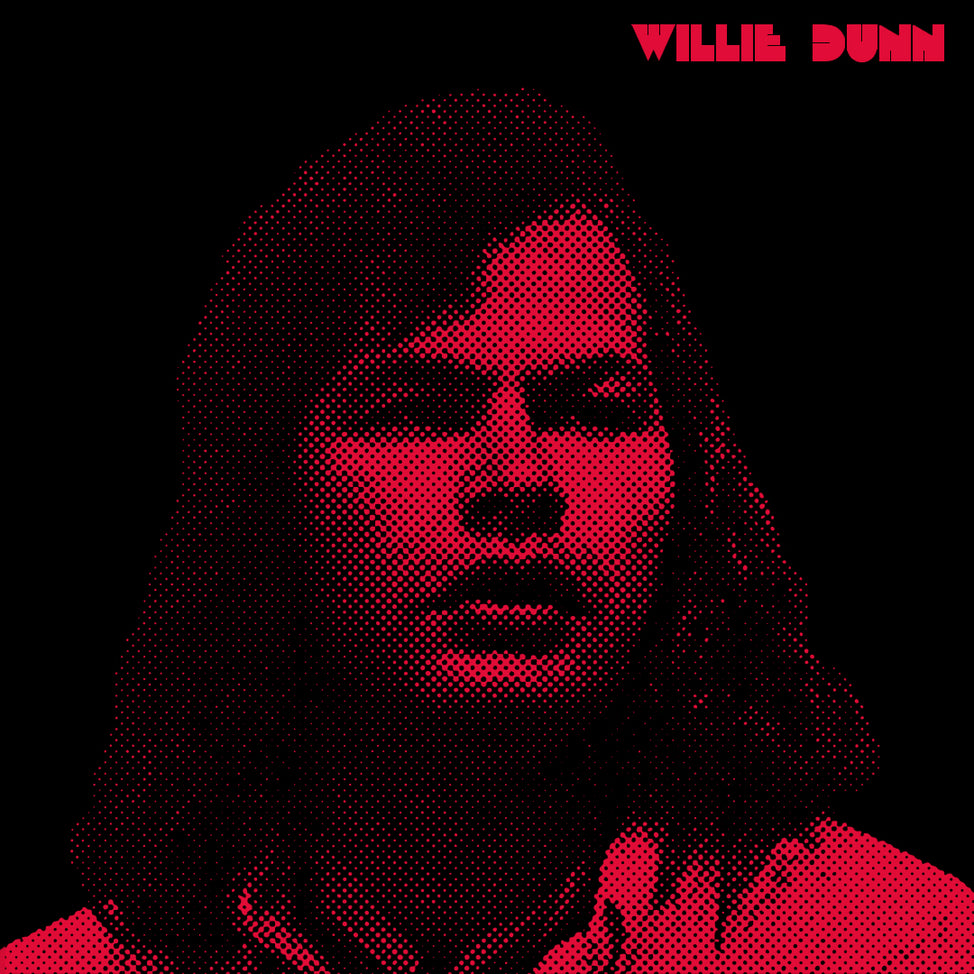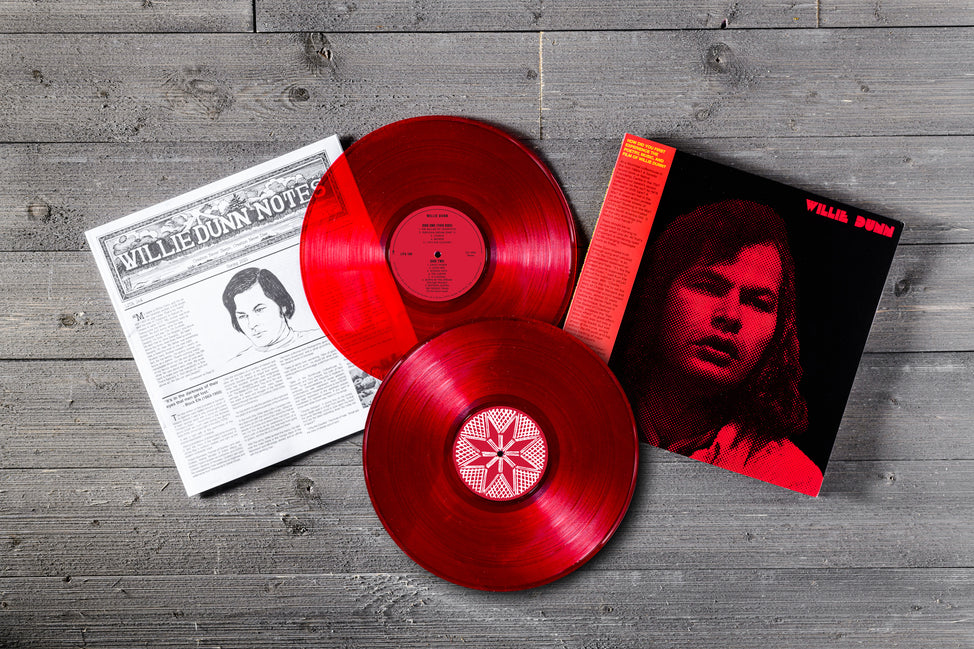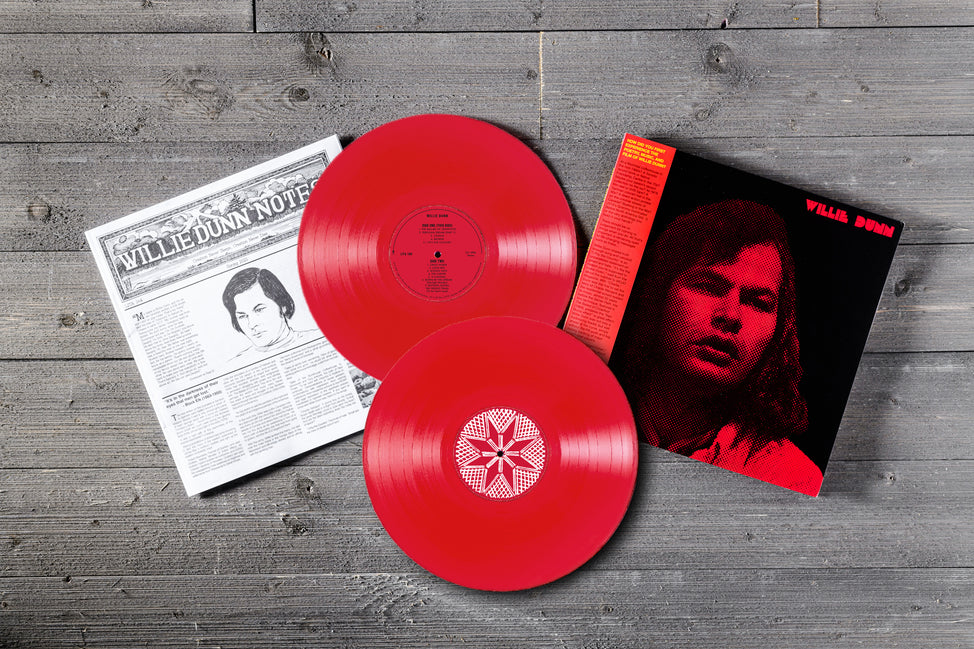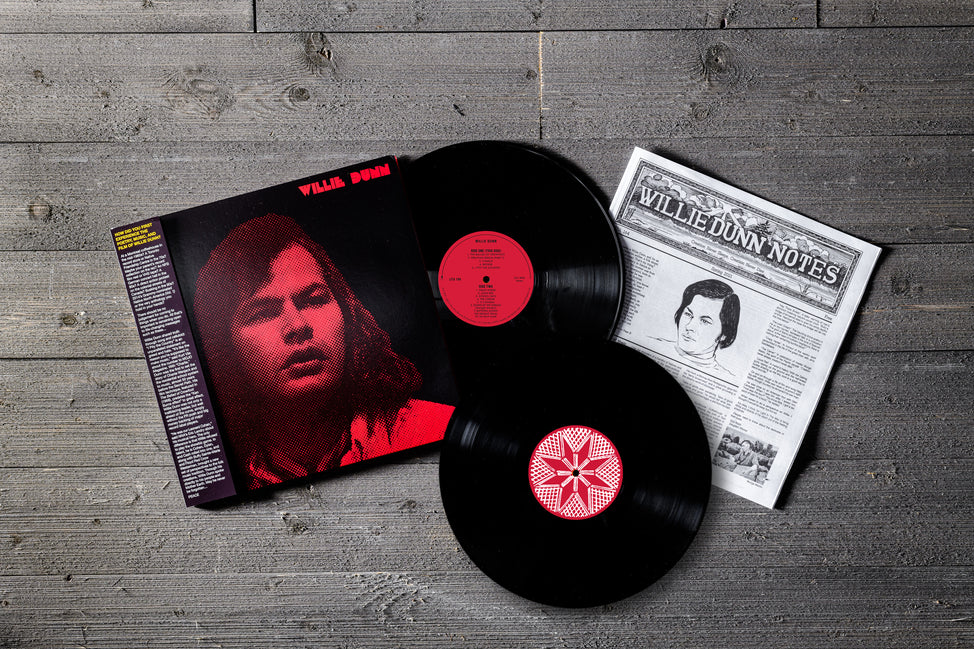Home Artist: Willie Dunn Creation Never Sleeps, Creation Never Dies: The Willie Dunn Anthology
Willie Dunn
Creation Never Sleeps, Creation Never Dies: The Willie Dunn Anthology
LITA 164
- The definitive overview of one of Canada’s unsung musical heroes
- Rare/previously unreleased recordings, photos, and interviews
- Lyrics, discography, and filmography
- Audio re-mastered by John Baldwin Mastering
- Artwork by Christi Belcourt and Alanna Edwards
- Liner notes by Kevin Howes (Voluntary In Nature)
- Contributions from the Dunn family, Bob Robb, and Alanis Obomsawin (OC)
- Vinyl pressed at RTI
- Indie Retail Exclusive Color – Translucent Red Wax (First Image) [Available to Record Stores only]
Description
How did you first experience the poetry, music, and film of Willie Dunn?
In a Montreal coffeehouse during the mid-1960s? On a CBC Indian Magazine broadcast with host Johnny Yesno? At a Toronto record store or Native Friendship Centre at the turn of the 1970s? Waiting outside of the Mohawk Nation Longhouse? Maybe in your parent’s record collection on the Rez? A White Roots of Peace gathering? Pow wow? The Mariposa Folk Festival? Or was it that Save James Bay Benefit back in ‘73? On a good friend’s stereo? Sitting around a crackling campfire? How about an old NFB film reel or VHS tape in high school? Or while attending Manitou College? A German concert hall in the 1980s? Maybe a direct action protest on the colonial streets of Canada? Busking in Ottawa during the 1990s? College radio? At Willie’s celebration of life service in 2013 alongside Alanis Obomsawin and Willy Mitchell? LITA’s Grammy-nominated Native North America (Vol. 1) compilation or the very anthology you hold in your hands?
There should be no judgement for coming to things when you do. All that’s important is remaining open to life-changing messages such as these…
Willie Dunn shared truth through song and celluloid. His original composition, “I Pity the Country,” is an unparalleled statement on the greed and hate created by humankind, recorded in 1971 and still unfortunately needed today. “It’s like the reason you’re supposed to make music,” said Kurt Vile about the song to MOJO Magazine in 2015. With “Charlie,” Willie was the first to deliver the devastating story of Chanie Wenjack and the Canadian residential school system to the music community, nearly 50 years before the much-celebrated Secret Path, yet ignored outside of Indian Country and the folk festival circuit. Dunn’s film technique, featured in 1968’s The Ballad of Crowfoot (NFB), predates the “Ken Burns effect” to great effect. Are you catching the drift? Willie Dunn was not only a trailblazing leader in his time, but well ahead of the curve, simply without the PR push and big money backing of major label players.
“He was our Leonard Cohen,” said singer-songwriter Eric Landry about his musical hero. The only difference is that Willie refused to play the Hollywood showbiz game. In talent, he is Cohen, Dylan, and Cash rolled into one and along with Buffy Sainte-Marie, Floyd Red Crow Westerman, and A. Paul Ortega, brought a new set of perspectives and realities to the folk music tradition. Willie spoke directly to his people and Mother Earth through his creations, not only from experience, but by examining his roots and connecting with the world in which he lived. We are humbled to help honour Willie Dunn. May he never be forgotten… PEACE
Artist Bio
Considering the enormous cultural influence of poet, singer-songwriter, musician, filmmaker, artist, playwright, activist, and politician William “Willie” Dunn (1941-2013), the Montreal-born trailblazer can accurately be described as a legend. Born to a Mi’gmaq mother and father of English/Cornish descent, Dunn was raised in Montreal with six sisters and a brother, though as a child he spent a short time living in Restigouche (Listuguj), his mother’s birthplace, located on the southwestern shore of the Gaspé Peninsula, an integral part of the Gespe’gewa’gi (“The Last Land”) district and Mi’gma’gi.
At eleven, Dunn discovered the music of Hank Williams and started playing the country’s greatest songs with a guitar given to him by his brother-in-law and sister at Christmas. As a teenager, Dunn spent hours listening to his musical hero and tried his best to pick apart Williams’ compositions. Dunn was a natural and started writing his own tunes within no time. He attended Montreal’s Rosemount High School in the 1950s, but dropped out after Grade 10 and enrolled in the Canadian Armed Forces.
After basic training at CFB Borden in the province of Ontario, Dunn was sent to Africa in support of the United Nations peacekeeping initiative in the Congo region. Upon his return, Dunn left the army and picked up his dusty guitar. He also started writing poetry (as did Dunn’s father, a one time hobo, and poet in his own right, as well as a friend of notable writer and humorist Stephen Leacock).
Another spark for Dunn was a reverberating question from a Congolese teacher that Willie had met in Africa. The teacher expressed curiosity about the current status of Canada’s Indigenous peoples, eventually inspiring the burgeoning songwriter to learn more about his Native heritage. Dunn returned to Restigouche to visit his extended family and establish a stronger connection with his Mi’gmaq roots. Though a city boy at heart, Dunn felt loved and welcome in the community and visited whenever possible.
At the dawn of the 1960s, Dunn became active in the North American folk music scene, which provided him with an opportunity to further practice his craft and network with peers at hot spots like Montreal’s Fifth Dimension coffeehouse and later, the seminal Caffè Lena in Saratoga Springs, New York, whose stage was graced by the likes of Pete Seeger and a young Bob Dylan.
In the mid-1960s, Dunn helped to open a coffeehouse of his own in Montreal called The Totem Pole on Rue Stanley. Still, the beckoning road, travel, and a desire for new experiences meant that Dunn didn’t stay settled in any one place for too long. Trekking across Turtle Island with an open mind and talent to burn, the roaming singer-songwriter lived the life of an old-time troubadour and grassroots radical. He relocated to New York City for a short spell, performing in Greenwich Village. Dunn then headed west, spending time on the Canadian Prairies as well as enjoying a yearlong stay in Vancouver, British Columbia, where he helped to form the Native Alliance for Red Power. He also contributed a selection of original music to George Ryga’s acclaimed 1967 play, The Ecstasy of Rita Joe. Throughout his journey, Dunn connected with a diverse selection of Indigenous people from all walks of life, observing, learning, and interacting with their traditions, vibrancy, rights, and struggles. In addition to his being, such gleanings would become a central focus of his creative output.
In the late 1960s, it appeared that Willie Dunn was everywhere. Back home in Montreal, he performed at Expo 67 where he met Samson Cree First Nation hoop dancer and musician Jerry Saddleback. Dunn also joined forces with Ojibway dancer, actor, media personality, and prominent Native advocate Johnny Yesno, who facilitated an extensive song writing commission for Dunn from the Canadian Broadcasting Corporation’s (CBC) Indian Magazine, later known as Our Native Land, a national half-hour news and cultural events radio program centred on Indigenous life in Canada. Dunn was already a CBC veteran at this point, having sung two songs on the national broadcaster’s Songs of Man television show in 1965. It was during this busy period that Dunn penned the bulk of his most well-known honouring songs: “The Ballad of Crowfoot,” “Crazy Horse,” “Louis Riel,” and “Charlie.”
Willie also became involved with the National Film Board of Canada (NFB) through their Challenge For Change program, an initiative that used film production to spotlight pertinent social issues among various communities across the country. The NFB’s “Indian Film Crew” was spawned from this project and taught Dunn the basics needed to shoot and edit his own celluloid visions. 1968’s The Ballad of Crowfoot was his first film, a devastatingly powerful short that combined archival images and newspaper clippings retrieved from the National Archives of Canada, all synced with his haunting and edifying song of the same name. Crowfoot, later emulated in technique by the likes of celebrated US filmmaker Ken Burns, brought Dunn widespread acclaim, winning a series of prestigious international film awards including recognition and a cash prize from the Academy of Motion Picture Arts and Sciences, the organization behind the fabled Oscar Awards.
Creatively, socially, and politically active, Dunn was a hard man to pin down moving forward into the 1970s. Avoiding the showbiz game, he deflected commercial record company interest including Columbia Records, home of Bob Dylan and Leonard Cohen, until a solid recommendation from Yesno led to an arrangement with Toronto-based conductor Howard Cable, the in-house producer for the short-lived Summus Records label.
Together with his long-time guitar picker Bob Robb, plus Norman Ricketts on bass, Jerry Saddleback on drums, Toronto jazz session great Jack Zaza on flute, and well-known fiddle player Al Cherney, Dunn captured nine original compositions for Cable and the recordings were released as the first long-playing album on Summus. “I Pity the Country” showcases its author’s perceptive worldview and poetic mastery, while “Peruvian Dream (Part 2)” features an intense vocal from Saddleback and a hypnotizing pow wow-meets-rock and roll backing. Unfortunately for Dunn, Summus, like many minor Canadian record labels of that era, had extensive distribution problems, and Willie Dunn [SUS 50,001] didn’t reach its rightful audience.
Unfazed by the volatile nature of the music business and fully aware of his songs’ strengths, Dunn attempted to rectify the situation by re-recording his songbook a year later at André Perry Studios in Montreal. To note, Perry had recently recorded “Give Peace a Chance” for John Lennon and Yoko Ono. Supporting Dunn’s cause was the White Roots of Peace, a Mohawk Nation grassroots movement, which helped produce the album for distribution on Robert Nickford’s Kot’ai imprint. In solidarity, Dunn donated the profits from sales of his record for the White Roots of Peace to help publish Akwesasne Notes, a seminal Indigenous newspaper/journal. Recorded with a backing band including fiddle champion Lee Cremo and Paraguayan harp player Eralio Gill, Willie Dunn [KOT-3000] is Dunn’s most celebrated release and a landmark album for his people.
With a slightly altered track listing from the self-titled Summus LP, the White Roots of Peace disc not only resonated with First Nations, Métis, and Inuit audiences on a deep and personal level, influencing a younger generation of aspiring Native singer-songwriters like Willy Mitchell, Willie Thrasher, and Lawrence Martin, who felt empowered by Dunn’s words and songs, but also struck a chord with Canadian settler and immigrant listeners as well as people from as far away as Japan and Germany.
With his earth shaking songbook now firmly established, the multidisciplinary artist shifted back toward filmmaking, continual activism—Dunn was involved in the creation of the Native Council of Canada, now known as the Congress of Aboriginal Peoples—and a steady stream of gigs. Dunn co-directed The Other Side of the Ledger: An Indian View of the Hudson’s Bay Company (1972) with Martin Defalco and also contributed songs, production help, and a brief cameo to Defalco’s feature-length Cold Journey (1975) about the Canadian residential school system. Dunn had previously brought much needed attention to this Indigenous genocide by setting the tragic story of Chanie Wenjack to song in “Charlie,” almost 50 years prior to Gord Downie of The Tragically Hip’s much-celebrated Secret Path project. Unfortunately, Dunn was notably absent in the majority of colonial coverage of Downie’s well-intentioned efforts.
The remainder of the 1970s saw Dunn support and participate in the Save James Bay movement, expand his family (Dunn has previously fathered a child in the 1960s with his then partner), and share stages across Canada and the US with friends Floyd Red Crow Westerman, A. Paul Ortega, Alanis Obomsawin, Duke Redbird, Paul Ritchie, David Campbell, and Shingoose.
Interest from German journalist, author, and friend Claus Biegert helped spur the release of Dunn’s next two long players: The Pacific [US-0075] in 1980 and 1984’s The Vanity of Human Wishes [US-08-0111], both released on Trikont Records. Each album highlighted Dunn’s longstanding interest in English literature and poetry (Samuel Johnson, William Shakespeare, T.S. Eliot) as well as Native history and culture, the human condition, and environmental concerns. “Son of the Sun” shows Dunn at his most eloquent and transcendent, pure art and expression through guitar, voice, percussion, and a drum.
In the 1980s, Dunn toured Europe for the first time, playing venues in Switzerland, Germany, and Italy. In the early 1990s, he became active in mainstream Canadian politics, running for the New Democratic Party (NDP) in the Ottawa-Vanier riding. Painting also became an interest for Dunn in his later years. While his once-constant touring schedule had somewhat slowed down by the 2000s, he continued to perform until his passing in 2013 from a variety of health complications. Prior to his death, Dunn gave his blessing and support to producer, DJ, and journalist Kevin Howes on his Native North America project/series for Light in the Attic Records. Released in 2014, the Grammy-nominated compilation was dedicated to his memory. It would not have happened without his open contributions and collaboration.
Throughout his life, Willie Dunn stood tall amongst his better-known peers like Gordon Lightfoot, Leonard Cohen, Bob Dylan, Neil Young, Joni Mitchell, and Buffy Sainte-Marie. His music and films not only empowered, informed, and inspired the Indigenous peoples of Turtle Island, but also offered a much-needed perspective of the complexities of North American life for all to hear and see, not to mention the life-giving essence of Mother Earth. It was an honour to spend time in your presence, Willie. Thank you.
*Further information, interviews, photos, and resources can be found in the Willie Dunn Notes newspaper, a physical newsprint and PDF insert to accompany Creation Never Sleeps, Creation Never Dies: The Willie Dunn Anthology [LITA 164], available from Light in the Attic Records; Willie Dunn’s films can be viewed at nfb.ca (Keyword search “Willie Dunn”)












